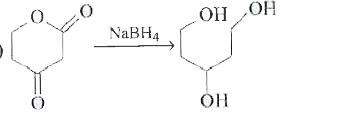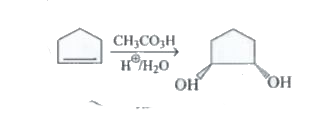Which of the following reaction are correct?




The correct Answer is:A, C
To determine which of the given reactions are correct, we will analyze each option step by step.
Step 1: Analyze Option A
- Reaction: Ethyl chloride (C2H5Cl) reacts with ammonia (NH3).
- Mechanism: This reaction proceeds via an SN2 mechanism, where the nucleophile (NH3) attacks the electrophilic carbon attached to the chlorine (Cl) atom.
- Product: The chlorine atom is replaced by an amino group (NH2), resulting in the formation of ethylamine (C2H5NH2) and ammonium chloride (NH4Cl) as a byproduct.
- Conclusion: This reaction is correct.
Step 2: Analyze Option B
- Reaction: A tertiary alcohol reacts with aqueous KOH.
- Mechanism: Aqueous KOH typically favors nucleophilic substitution (SN) rather than elimination. In this case, the chlorine (Cl) would be replaced by a hydroxyl group (OH) rather than undergoing elimination.
- Expected Product: The expected product should be a tertiary alcohol (with OH replacing Cl), not a double bond.
- Conclusion: This reaction is incorrect.
Step 3: Analyze Option C
- Reaction: Chlorocyclohexane reacts with alcoholic KOH.
- Mechanism: Alcoholic KOH promotes elimination reactions (dehydrohalogenation). In this case, both H and Cl are removed, leading to the formation of a double bond in cyclohexene.
- Product: The product is cyclohexene, which is formed by the elimination of HCl.
- Conclusion: This reaction is correct.
Step 4: Analyze Option D
- Reaction: A primary amine reacts with nitrous acid (HNO2).
- Mechanism: When a primary amine reacts with HNO2, it forms a diazonium salt (R-N2^+Cl^-) which is unstable in the aliphatic case. It will eventually convert to an alcohol (R-OH) upon hydrolysis.
- Expected Product: The product should be a primary alcohol, not a tertiary alcohol.
- Conclusion: This reaction is incorrect.
Final Conclusion
The correct reactions are:
- Option A: Correct
- Option B: Incorrect
- Option C: Correct
- Option D: Incorrect
Thus, the correct reactions are A and C.
---
- Reaction: Ethyl chloride (C2H5Cl) reacts with ammonia (NH3).
- Mechanism: This reaction proceeds via an SN2 mechanism, where the nucleophile (NH3) attacks the electrophilic carbon attached to the chlorine (Cl) atom.
- Product: The chlorine atom is replaced by an amino group (NH2), resulting in the formation of ethylamine (C2H5NH2) and ammonium chloride (NH4Cl) as a byproduct.
- Conclusion: This reaction is correct.
- Reaction: A tertiary alcohol reacts with aqueous KOH.
- Mechanism: Aqueous KOH typically favors nucleophilic substitution (SN) rather than elimination. In this case, the chlorine (Cl) would be replaced by a hydroxyl group (OH) rather than undergoing elimination.
- Expected Product: The expected product should be a tertiary alcohol (with OH replacing Cl), not a double bond.
- Conclusion: This reaction is incorrect.
- Reaction: Chlorocyclohexane reacts with alcoholic KOH.
- Mechanism: Alcoholic KOH promotes elimination reactions (dehydrohalogenation). In this case, both H and Cl are removed, leading to the formation of a double bond in cyclohexene.
- Product: The product is cyclohexene, which is formed by the elimination of HCl.
- Conclusion: This reaction is correct.
- Reaction: A primary amine reacts with nitrous acid (HNO2).
- Mechanism: When a primary amine reacts with HNO2, it forms a diazonium salt (R-N2^+Cl^-) which is unstable in the aliphatic case. It will eventually convert to an alcohol (R-OH) upon hydrolysis.
- Expected Product: The product should be a primary alcohol, not a tertiary alcohol.
- Conclusion: This reaction is incorrect.
The correct reactions are:
- Option A: Correct
- Option B: Incorrect
- Option C: Correct
- Option D: Incorrect
Topper's Solved these Questions
- AMINESBOOK - NCERT EXEMPLAR ENGLISHCHAPTER - AMINESEXERCISE - SATQ
37 Videos
- AMINESBOOK - NCERT EXEMPLAR ENGLISHCHAPTER - AMINESEXERCISE - LONG ANSWER
3 Videos
- ALDEHYDE, KETONES AND CARBOXYLIC ACIDSBOOK - NCERT EXEMPLAR ENGLISHCHAPTER - ALDEHYDE, KETONES AND CARBOXYLIC ACIDSEXERCISE - Long Answer Type Questions
4 Videos
- BIOMOLECULES BOOK - NCERT EXEMPLAR ENGLISHCHAPTER - BIOMOLECULES EXERCISE - Long Answer Type Questions
5 Videos
Similar Questions
Knowledge Check
Which of the following reactions are correct ?
A B
B C
C DCH3−C≡NLiAlH4−−−→CH3CH2NH2
DCH3−C≡NLiAlH4−−−→CH3CH2NH2Which of the following reactions are correct?
A B
B C
C D
D
Which of the following reactions are correct?
A B
B CCH3−O∣∣C−ClPhMgBr−−−−−→H⊕/H2OCH3−O∣∣C−PhDPhMgBrCO2−−−−−→H⊕/H2OPh−O∣∣C−OH
CCH3−O∣∣C−ClPhMgBr−−−−−→H⊕/H2OCH3−O∣∣C−PhDPhMgBrCO2−−−−−→H⊕/H2OPh−O∣∣C−OH
